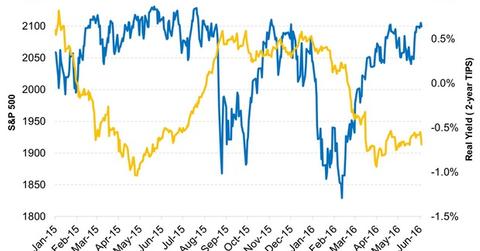How Rising Real Yields Could Affect Equities
Since the start of 2015, the S&P 500 and real yields have had a high negative correlation. Falling real yields have encouraged investors to take more risk in search of higher returns.
June 9 2016, Published 1:17 p.m. ET

We have downgraded our near-term view of global stocks to neutral. Global Chief Investment Strategist Richard Turnill’s chart of the week helps explain why.
This week’s chart helps illustrate why we’re taking a more cautious view of global equities over the near term.
Falling real (or inflation-adjusted) yields have often been a tailwind for equities in recent history, encouraging investors to move into riskier and higher-yielding assets, as the chart below shows.
As evident above, U.S. stocks have been in a sweet spot since mid-February, supported by solid economic growth and falling real yields on the back of expectations of a Federal Reserve (the Fed) on hold.
Yet yields have started rising again. Higher U.S. inflation and hawkish Fed comments have now put a mid-year rate increase back on the table, increasing investor anxiety and the likelihood of near-term volatility.
Market Realist – Rising real yields could affect equities negatively.
Since the start of 2015, the S&P 500 (IVV) (SPY) and real yields have had a high negative correlation of -0.52. We’ve used yields on two-year TIPS (Treasury Inflation-Protected Securities) (TIP) as a proxy for real yield. Falling real yields have encouraged investors to take on more risk in search of higher returns, which partly explains this negative correlation.
As real yields rose in mid-2015, equities went in the other direction. That said, rising real yields only partly explained the correction in equities and other risky assets. Real yields started falling again earlier this year, which has supported equities (OEF) (IWM).
However, real yields are beginning to rise again with the possibility of a rate hike this year. Poor employment figures for May saw only 38,000 jobs added. That could mean that the Fed might put off a rate hike in June. But a rate hike is still very possible later this year, especially if the May employment figure is a one-off.
In the next part of the series, we’ll see why global equities might struggle for the rest of the year.
